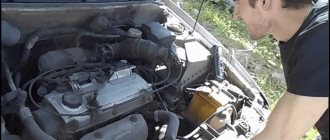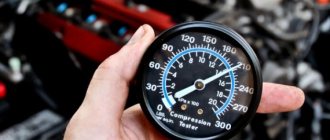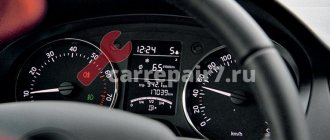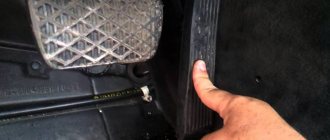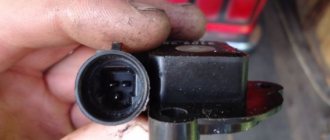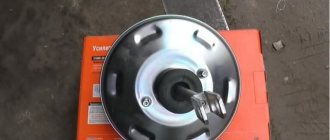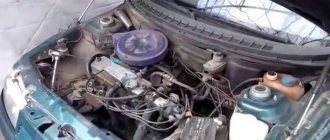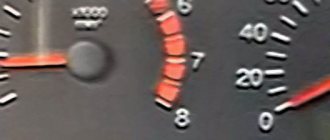Most car enthusiasts are faced with the problem of engine jolts during smooth or sudden acceleration. This problem is not critical and can be easily repaired. Moreover, users of both domestic VAZ 2112 with a 16-cl unit and owners of foreign cars such as Hyundai Solaris are not insured against this. If the car jerks when you press the gas pedal, you need to investigate such units.
- Fuel supply. As a rule, problems with acceleration begin after refueling at a questionable gas station.
- Air in the system. Excess oxygen may also leak through cracks or leaky clamps.
- Ignition. This topic is worthy of a separate issue.
- Pressure lines. Fuel pumps, ramps, injectors, filter inserts are units that require increased attention.
So, you need to figure out what to do when the car starts to jerk during acceleration.
The main reason for the car “jerking” when you press the gas pedal
The main reason is most often associated with an oxygen-rich/oxygen-depleted fuel mixture. It is because of the lack of air that the crankshaft continues to rotate despite the fact that the gas pedal has long been released. In addition, when the pedal is pressed sharply, the motor begins to twitch and rotate in place.
The root cause of the problem is preparing the wrong mixture. In turn, the mixture can be supplied to the engine in different proportions due to malfunction of other devices and components of both the engine and the fuel system.
Car jerking due to TPS malfunction
TPS is a special sensor that regulates the position of the throttle valve. It is quite simple to understand that the malfunction is connected with it - the engine begins to “jump” even when the accelerator is gently pressed. The process of jerking is as follows:
- The throttle remains ajar for a long time;
- After this, during acceleration, a faulty throttle position sensor belatedly transmits a signal to the on-board computer of the car;
- As a result, the car’s engine cannot quickly switch from idle to full speed in load mode, after which fuel is supplied in large quantities and sharply into the combustion chamber;
- The result is a sharp decrease in pressure in the fuel rail design. The engine will run jerkily at first, and then completely stall.
This type of malfunction can often be found in vehicles with injection engines. Both domestic cars (Lada Priora, Lada Vesta Cross, Lada Granta) and foreign car models (for example, the same Ford Focus) are not immune from this. In this case, there is only one solution - go to a car service center, where they will replace the faulty sensor.
Advice: do not try to solve the problem yourself by repairing a faulty TPS. As a rule, after repair, a previously faulty mechanism can last no more than 1-2 months.
Car jerking due to a malfunction of the mass air flow sensor
Mass air flow sensor
The second sensor that affects the air supply to the system is a device for regulating the mass flow of oxygen in the system. It works in injection-type engines and is responsible for supplying air during the formation of the fuel mixture. If this component is faulty, then your car will also twitch before it even has time to accelerate. The solution is similar with the first sensor - dismantling and completely replacing the mass air flow sensor.
Car jerking - malfunction in the carburetor chamber and pump
If the engine starts to run jerkily in carburetor cars even when the gas pedal is lightly pressed, the main attention should be focused on the carburetor chamber. The problem is often associated with clogged outlets, which are located in the first of the carburetor chambers.
When the fuel enters the engine, it takes with it some of the soot and metal shavings, as a result of which the mixture undergoes changes and the engine operates unstably. You can solve this problem yourself - just remove the carburetor and blow out all its pipes and holes with compressed air.
A classic example is the following situation: when replacing the front wheel bearing on a VAZ-2109, the pump was damaged. As a result of the failure of the carburetor accelerator pump, the mixture is supplied to the engine in an incomplete volume. The result is the appearance of jerks during even a smooth attempt to move away. In most cases, it seems impractical to repair pumps, which is why they are simply replaced at a car service center.
carburetor chamber
Air shortage
The air filter is designed to clean the air from road debris, dust and other components that can damage the engine. This element is capable of accumulating dirt to the point of complete obstruction. A clogged filter is the most underrated reason why your car will drive rough due to inefficient fuel combustion.
Another popular reason for a car's abrupt acceleration is the mass air flow sensor. The component performs the task of measuring the amount of intake air and transmitting data to the on-board computer. A defective or dirty sensor causes a loss of engine power and increased fuel consumption.
Oxygen sensors
Most modern car engines are equipped with oxygen sensors (lambda probes). Their number can reach several pieces, depending on the car model. The presence of such a control loop contributes to the smooth and economical operation of the engine. Typically, you can find two types of such sensors:
- Upflow lambda probes. Located inside the exhaust manifold and designed to measure the oxygen level in the vehicle's exhaust gases during the exhaust stroke. Their task is to control incomplete combustion.
- Downflow sensors. Located behind the catalytic converter. They transmit to the computer the information necessary to fine-tune the ratio of fuel and air in the mixture.
Car jerking during acceleration
This problem can occur during a smooth increase in speed, which is accompanied by a sharp short-term twitching of the vehicle. In this case, the reason is due to the lack of constant supply of the fuel mixture to the float chamber of the engine. That is, the fuel is burned in the chamber much faster than the fuel pump distils a new stream. As a rule, the breakdown can be found in the design of the fuel pump.
Solving a fuel pump malfunction takes place in 3 stages:
- Remove the top cover of the pump and carefully inspect the surface of the hole where the valve structure should be located;
- If the o-ring is worn or missing, attach a new one;
- If during diagnostics a depressurization of the chamber is detected or the problem is related to interruptions in fuel injection, then the final stage will be associated with the complete replacement of the inoperative valve and the further restoration of the sealed state in the system.
Advice: when making repairs, do not try to repair holes in the old cylinder and install it in place. This may subsequently lead to a major overhaul of the entire engine structure.
fuel mixture
Malfunctions that happen extremely rarely
The cause of turbocharged engines jerking during acceleration is often a malfunction in the turbine itself. Namely, in the pressure regulation system, this is a solenoid valve or electric actuator. But if the valve is being replaced, then with an electric drive everything is much more complicated. In other words, the turbine needs to be replaced.
If all of the above systems and consumables have been checked, and the car continues to jerk during acceleration, then the reason must be sought in the compression of the engine cylinders.
Uneven compression
In practice, in all engine cylinders there is an acceptable spread (1 kgf/cm2) in compression readings. It is measured with a compression gauge; its operation is similar to that of a pressure gauge. But if in one of the cylinders the compression has dropped significantly, and as a result the engine begins to twitch during acceleration. Under these circumstances, it is first necessary to find out the cause of the damage in the cylinder. Problems can be due to the occurrence of rings, misalignment of valves, cylinder head gaskets, and cylinder heads.
The appearance of jerking in the car when you sharply press the gas
If the cause is not related to the fuel pump, then these symptoms may indicate the so-called “triple” of the engine. A situation arises in a car in which out of 4 cylinders only one can work correctly. As a result of the “triple”, the engine simply cannot respond in time to pressing the gas pedal, after which similar problems arise. You can deal with the breakdown in the following ways:
- If the oxygen supply sensor is not working properly, the system is diagnosed using a multimeter. If any faults are found, it is simply replaced.
- If the valve timing in the engine is shifted, it is necessary, with the help of car service specialists, to adjust them according to the appropriate instructions.
- Detection of an incorrect glow number of spark plugs is resolved by installing a new set with the correct number.
- The problem of clogged injectors can only be solved at a car service center. To do this, they are installed on a special stand, which simulates the operation of a motor, and washed with a special solvent.
- The problem can also arise if the emulsion tube and well located in the design of the second chamber of the carburetor engine are clogged. The only solution here is to flush the carburetor and pipe with kerosene.
Poor quality fuel
Gasoline is the “food” for a car. If bad fuel is used, the vehicle will not be able to operate properly. If the car jerks noticeably when you step on the gas, you need to remember what kind of fuel was filled and at what gas station. The problem arises due to low-quality gasoline, or the fuel does not have the correct octane number, so a normal mixture cannot be formed.
Attention! It is not recommended to drive with such fuel; the fuel system may become clogged.
To check, you need to drain the fuel, flush the system, and add new gasoline at another gas station. If the problem goes away, you need to drive around the ill-fated gas station; if not, you should look for the cause.
Engine jerking due to problems with the ignition system
If, when the car picks up speed, you observe sharp drops in power, then the reason lies in malfunctions of the ignition system elements. This problem applies to any type of engine. The only correct solution is to check the ignition with the engine turned off. It is carried out by the following signs:
- The tightness of the pads with the wires is checked;
- No chips and good condition of the reel;
- The wiring connecting the ignition system to the engine is in good condition.
After checking all the elements, you need to start the car and just listen to how the engine began to work. If you notice the appearance of characteristic clicks, it means that there are small breakdowns in the system with high voltage. In this case, you will have to buy all the elements of the ignition system - a coil, a block and a set of high-voltage wires.
Tip: Do not try to replace the wiring on your car yourself. Only highly qualified specialists can, using instructions and diagrams, correctly connect relays and fuses, after which the ignition system will not burn out. You can also check the wheels at the same time by checking the car tire pressure table.
If the engine runs smoothly, the problem may lie in the spark plugs. And to put it more precisely - in the absence or rare appearance of a spark. The presence of defects in the spark generation system can be easily detected if the car engine starts to run jerkily when descending from hills and even on flat sections of the road.
For example, a problem with a set of spark plugs is typical for vehicles under the Nissan brand. This is due to the equipping of their SA-18 model engine with a special non-contact distributor design. The distributor housing contains a switch, if it malfunctions, the spark signal does not arrive at the on-board computer, and such a specific movement of the machine occurs. Motor jerking can be corrected only by completely replacing the distributor components.
If the set of spark plugs is in excellent condition, the only remaining cause may be a malfunction in the operation of the carburetor-type engine control unit. In this case, jerks do not occur constantly, but randomly and only during a long drive of the car.
It is possible to detect faults in the control unit only after diagnostics in a car service center on a special stand. Also, with the help of a lift, you will be able to see that the car twitches occasionally when idling. As a result, the control unit (EFI) should be replaced along with faults found in other components of the vehicle.
car pads
What to check first
Experienced drivers know that the ignition system should be checked first. It includes spark plugs, armored wires and an ignition coil.
Malfunction in the ignition system
First, you need to check the spark plugs. Soot on the spark plugs leads to misfire, but it will also help determine the quality of gasoline. Namely, the appearance of a white coating or carbon deposits on the electrodes indicates low-quality fuel. The spark plugs, of course, can be cleaned, but it’s better to buy new ones. Fuel must be changed and refueled only at proven gas stations.
Secondly, it is necessary to check the high-voltage wires (armored wires). They transmit electrical impulses from the ignition coil to the electrodes of the spark plugs to ignite the air-fuel mixture. A breakdown is easy to detect with the naked eye. This is done like this: turn on the engine, inspect the wires in the dark, if they spark, then there is undoubtedly a breakdown. If there is a breakdown of the armored wires, they most likely need to be replaced.
Thirdly, an incorrectly set ignition may be the cause of the power unit “jerking” during acceleration. Thus, the list of faults includes the ignition distributor, switch, slider or distributor cap.
Engine control unit calibration
The engine control unit is an important component for the proper operation of the power unit. The parameters in the firmware may have gone wrong due to an error when connecting the equipment or for other reasons.
You should try restarting the software. If the problem is not solved, the electronic control unit will need to be reflashed. It is not recommended to do anything with the “brains” of the car unless you have special equipment and skills. Incorrect actions can lead to damage.
Drop in injector speed
The characteristic “thoughtfulness” when vigorously pressing the gas pedal indicates incorrect operation of the injectors or fuel pump. You can check whether the quality and volume of the mixture your car “feeds” corresponds to the standard through detailed diagnostics. Separately, you need to remove the injectors and check their performance on a bench.
It is easier to look for the cause in a sequence from simple to complex: change the fuel, flush the tank, replace the filters, check the pump mesh in the tank and the pressure in the rail, then test the injectors.
Some injectors can be restored, others will have to be replaced, correctly registering the replacement in the “brains”. Difficulties during acceleration can also be a sign of a malfunction of the electronic unit that controls the injection system. If it cannot be eliminated by chipping, the “brains” will have to be changed.
